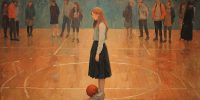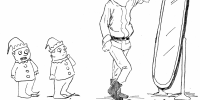I have always appreciated a good romance novel. Growing up, books were always an escape I knew I could count on. Only 13 years ago, Elder Holland commented: “The darker side of the movie, television, and music industry step further and further into offensive language and sexual misconduct.” Notably absent from this statement is “books” as a form of entertainment. That is not to say that people could not find sexually explicit book content if they were looking for it. I would posit, however, that it was not as easily accessible or socially promoted as it is now, and that is ultimately what is reflected in Elder Holland’s statement. In the past, you could walk through the teen and young adult sections and could usually count on a level of respect as it pertains to sexually explicit content. Today that is most certainly not the case. Increasingly, authors are writing sexually explicit content across fiction audiences. I have often bemoaned the fact that I cannot let my children grow up and browse the teen section at Barnes and Noble as I used to do because I am not confident that the books contain appropriate material. In fact, they more than likely do not. The casualness with which I used to be able to approach literature is a concept of times gone by.
Broadening Our Understanding of Pornography
It was not uncommon during my adolescence for a prophet, an apostle, or a general authority to give a talk on the pervasiveness of pornography. Usually, it was within the context of addressing men, but not universally so. As evidenced by the earlier Elder Holland statement, pornography discussions were usually within the context of visual stimuli like movies or pictures. Research has noted that men are typically more invested in visual pornography, so it would make sense to discuss such topics within that context. Huge movements like Fight The New Drug particularly emphasize video and online pornography and their effects on relationships. Typically, the arguments against this form of pornography entail points on sexual exploitation, sex trafficking, and other forms of abuse and mischaracterization. While this is a worthwhile movement, it does emphasize visual stimuli instead of the other forms of pornography available. Increasingly, authors are writing sexually explicit content.
With this in mind, it is important for us to denote what pornographic content actually includes. More generally, pornography refers to “sexually explicit media that are primarily intended to sexually arouse the audience,” in which literature and audio forms are included. So, when we discuss the detrimental effects of pornography on an individual, we are referring to an all-encompassing definition of pornography and not just more common conceptualizations. Notably, women are less visually stimulated than men and usually require more “mental mapping,” which is to say that women typically appreciate more storytelling and “set-up” than men do. Forbes noted that 90% of women use this sort of mental framing to get sexually aroused. Thus, erotic books and forms of audio pornography (including but not exclusive to audiobooks) tend to be more appealing to the feminine demographic and are still detrimental to the listener/reader.
Romance Novels and “Sexual Empowerment”
In current society, romance fiction has been one of the fastest-growing media markets over the last several years. Unsurprisingly, some reports indicate that 82% of romance readers are women. It is interesting that this noted increase corresponds with the normalization of erotic fiction in the public sphere. With the release of Fifty Shades of Grey, pop culture started to shift to the social acceptance of literary erotica. Notably, this book sold over 150 million copies worldwide and created a movie franchise that produced additional millions in revenue. While not all sexually explicit books are as widely known or in the same romance genre, the rise in acceptability of such content is alarming. The promotion and normalization of sexual content also seem to correspond to parts of the feminist movements focused on sexual empowerment and sex positivity. There is a glaring lack of discussion around literature and/or audio forms of pornography.
Some arguments for sexually explicit content in books note that women have learned new things that have brought enjoyment into their sex lives with their partners. Additionally, women (and men) from a secular perspective can learn more about consent, safe sexual practices, and healthy sexuality. Having access to this sort of content has had ‘positive’ effects. In fact, while pornography usually decreases sexual drive in men, reports have indicated that it increases sexual drive in women. Indeed, many Instagram reels and female influencers have joked that their husbands and partners are the ones buying them their books for those very reasons. This “educational” purpose of fictional erotica can be compelling; however, in a study among women reading sexual content, it was noted that the number one reason women wanted to read such material was for the distraction it provided for them. While noting that this is not necessarily generalizable, it does bring forth the notion that, truly, at the core, pornography is a numbing agent similar to other materials that can be addicting. Further, the type of sex life promoted within these stories can pervade our understanding of human sexuality as a whole. Reading sexually explicit material, especially when those perspectives are grounded solely in secular understanding, can distort the meaning of sex. Using these sources as an authority would concede that we view sex as purely transactional for personal pleasure. Therefore, it’s not just sexual education, it is bad sexual education rooted in ideas that are incredibly deteriorative in nature. However important a healthy sexual relationship is with a spouse, it is not the sole purpose. We can lose sight of that when we consume material that promotes a sex life at odds with what we believe. After all, it is a well known fact that what media we consume influences our perceptions and understanding. Even if we know that sex should go beyond simple pleasure and transaction, if we read content that focuses on sex as just that, eventually, it can influence how we understand sex and, consequently, lead us away from the truth.
What Then?
Perceived improvements in some areas of sex life do not necessarily mean that the same results and excitement could not happen with other forms of sexual education more in line with the gospel. There is a difference between reading or looking at imagery like diagrams, stick figures, and so forth for educational purposes with one’s spouse rather than using such material to incite pleasure alone. This area is where using righteous discernment is of the utmost importance. The intent in which we engage with sexual materials matters, but pure intent does not absolve wrongdoing. Pornography is a numbing agent.
I will concede to the fact that there are not great resources (or at least not very well known) that help couples learn about the mechanics of sex within a Christian perspective. While I understand the need to keep sacred things sacred, when you have Christian couples that have not engaged in such activities before marriage, we need to find ways to help them feel more prepared for sexual intimacy in a way that also promotes an accurate gospel perspective on human sexuality. If we do not provide education, it will be searched out elsewhere for worse or better. But here are some available resources that are a starting point to fill this gap:
Replenish: Creating Sexual Fulfillment in Marriage, A Guide for LDS Couples by Tammy Hill

















